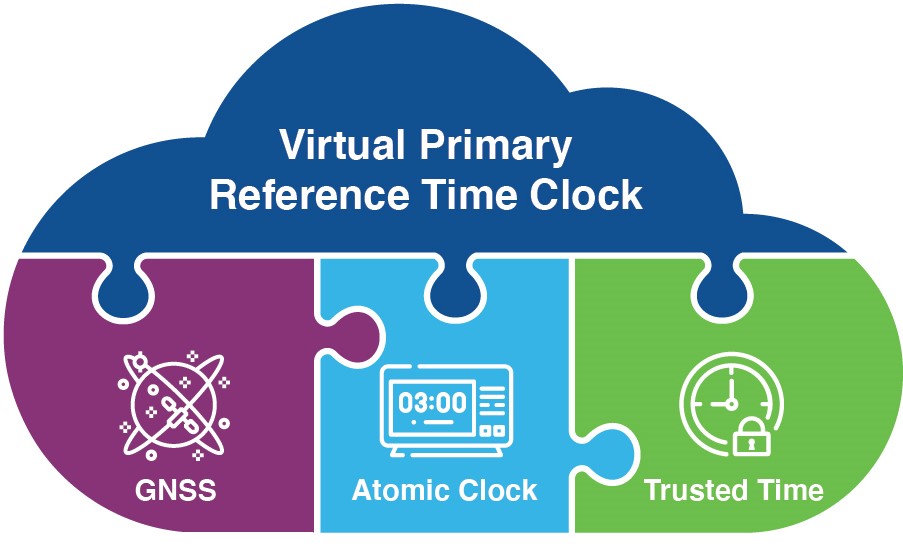TimeProvider 4100 Release 2.2
Precise Timing Grandmaster with Gateway Clock, PRTC-B, High-Performance Boundary & Enhanced PRTC
TimeProvider® 4100 is a family of solutions based on a hardware platform with a choice of oscillators that can be complemented by optional expansion modules and by unique differentiating software options that are made available in successive releases. This approach ensures the preservation of investments in a platform that evolves with industry needs and standard evolutions.

![]()
New Features for Release 2.2
TimeProvider 4100 Release 2.2 builds upon prior releases by adding the following key capabilities.
- Redundancy : one Active unit and one Standby unit are directly linked to offer a redundant solution enabled via software, no need for additional hardware module
- Multiband GNSS : new receiver module inside the unit is now capable of supporting single band by default and can be enabled via license to support Multiband for mitigation against ionospheric delays, no need for additional hardware module
- Super OCXO : additional oscillator choice with enhanced timekeeping holdover performance
- Security : enhanced capabilities including support for standard authentication servers (TACACS+, Radius), enhanced SSH with support for high security profiles as well as enhanced anti-jamming & spoofing capabilities and metrics
- Monitoring : added support for legacy signals monitoring (E1/T1, 10Mhz) with MTIE
Flexible Architecture
- Rich base platform with support for PTP, NTP and legacy frequency timing interfaces
- Ports of many types : 4xE1/T1, 2xRJ45 1GE, 6xSFP 1GE, 2x1pps/ToD, 1 GNSS, 1 Craft
- Optional Expansion Module with 16xE1/T1 output ports
- Optional Expansion Module with 4xSFP 1GE and 4xSFP+ 1GE/10GE fan out ports and 100M Fast Ethernet
Best-of-Breed Grandmaster Clock
- Industry-leading IEEE 1588 v2 grandmaster with support for multiple profiles per unit
- Telecom 2008, Default profile, G.8265.1, G.8275.1, G.8275.2
- SyncE input & output
- NTP with MD5 security
- Multiple packet services per unit, each port can be configured separately for master or client or probe or NTP
- Dedicated management port (RJ45 or SFP)
- Operator can select number and types of ports and interfaces that are necessary to deploy and scale for use cases such as 5G, cRAN, oRAN, DOCSIS remote/MAC PHY, etc.
- Primary Reference Time Clock : Class A (100ns), Class B (ITU-T G.8272, 40ns), ePRTC (30ns)
- 790 PTP clients capacity at full rate of 128 packet per second in unicast
- Sub-tenancy model enable to double capacity and scalability by using a master unit connected to downstream client units; port count is doubled with two units.
Resiliency & Redundancy
- Dual power input for power redundancy
- Fan less device minimizes risks associated with rotation and moving parts
- Heat sinks and heat pipes enable great scalability with SFP and SFP+ ports
- Oscillator options (mini OCXO, OCXO, super OCXO, Rubidium) for time-keeping and holdover enhanced performances depending on use case and requirements (edge, aggregation, core)
- Support for all major GNSS Constellations (GPS, GLONASS, Beidou, Galileo) and SBAS allows for enhanced resiliency by enabling to lock to more satellites
- Support for Multi-band GNSS to mitigate time delay due to solar storms and ionosphere effects. Each unit is hardware enabled with Multiband receiver. L1 is set per default, upgrade to multiband does not require a new hardware module
- Microchips' patented active thermal compensation technology for excellent accuracy of <10ns RMS to UTC (USNO)
- PTP client input with patented automatic asymmetry compensation (AAC) provides best of class assisted partial timing support (APTS) on 32 paths as back up to GNSS signal. AAC with APTS mitigates for packet delay variation (PDV), jitter and asymmetry
- Geographical network redundancy for failure leverages IEEE 1588 PTP Best Master Class Algorithm (BMCA)
- Software redundancy with no need for additional hardware modules. Two units use Active/StandBy model with direct fiber link, co-location, continuous health monitoring and fast switching from passive to active when needed
- TimeProvider 4100 is a key member of the virtual PRTC solution. TP4100 can be configured as ePRTC, Gateway Clock as well as with High Performance Boundary Clock. vPRTC provides an architecture for redundant, resilient and highly accurate distribution of phase (PRTC-A over long distances) using optical networks such as DWDM
Security
- Firewall capabilities to block any unauthorized protocols
- Secure protocols such as SSH & HTTPS
- Enhanced SSH with configuration of security levels including High Security
- TACACS+ and Radius Authorization and Authentication support
- Updates for relevant CVEs and other vulnerabilities
- Anti-Jamming and anti-spoofing protections including indicators (AGC Automatic Gain Control and CW Continuous Wave) and remediation measures based on thresholds
Synchronization Management and Monitoring
- Full FCAPS via Microchip's TimePictra® synchronization management system and via CLI
- webGUI for user friendly display of Monitoring configuration and results
- Internal logging, SNMP support
- Dedicated Management port on main chassis and also on 1GE/10GE optional module
- In-band management
- Monitoring of PTP, 1pps for phase as well as legacy signals such as E1/T1, 10Mhz. Measurements (TIE, MTIE)
- TimePictra can present monitoring results as well as graphs for ePRTC and chains of high performance boundary clocks
Multiple Operation Mode
Mode of Operation is an essential capability focused around which of the multiple inputs can be used as synchronization reference. The unit can still behave as a fully functional grandmaster from an outputs standpoint and also has the capability to monitor various kinds of inputs, but a key set of specific inputs can be used as reference for a specific Operation Mode. Various Operation Modes will be introduced over time on TimeProvider 4100. TimeProvider 4100 now supports three Operation Modes:
- Gateway Clock mode
- High-Performance Boundary Clock mode (Single domain and Multi domain)
- Enhanced Primary Reference Time Clock (ePRTC)
Gateway Clock Mode
- New class of synchronization device with multiple inputs and fan out capabilities for distribution of timing flows to multiple end points
- Translation of PTP timing profiles
- No license, Gateway Mode is the default of the TimeProvider 4100 device
High Performance Boundary Clock Mode
- High Performance Boundary clock meets Boundary Clock Class C (10ns cTE) and Class D (5ns Max |TE|)
- Single Domain (SD) or Multi Domain (MD)
- MD HP BC is typically used for redundant, resilient and high-accuracy distribution of phase over long distance on optical networks (DWDM)
- Key element of virtual PRTC (vPRTC) end to end solution
- Leverages Optical Timing Channel (OTC) : hop-by-hop deployment of TP4100 HP BC at every optical node, with dedicated lambda for time distribution
- HP BC does not require hardware change, HP BC is enabled by a software option
Enhanced PRTC Mode
- No hardware needed, ePRTC is enabled via software license
- TP4100 ePRTC mode meets ITU-T G.8272.1 30ns
- Flexibility to use a standard Cesium (Time Cesium 4400/4500) or a high performance Cesium (5071A)
- Fully Protected TimeScale
- Holdover Gas Gauge and extended holdover (beyond the 14-day requirement by the standard)
- Commissioning Guidance and Recommendations
TimeProvider 4100 Features and Benefits
- IEEE 1588v2 Precision Time Protocol (PTP) grandmaster
- Redundancy via software mechanism using two units with health monitoring of Active and Stand-By devices
- SyncE including enhanced ESMC & eEEC
- NTP Reflector with highest capacity, NTP Daemon (NTPd) with MD5 authentication and NTP logs
- GNSS with multi-constellation support (GPS, GLONASS, BeiDou, QZSS and Galileo)—and SBAS support
- GNSS with multi-band L1/L2/E5B support
- Primary Reference Time Clock (PRTC) Class A and Class B
- Enhanced PRTC (ePRTC) ITU-T G.8272.1, 30ns
- Reliable Fanless Passive Thermal Operation
- Oscillator options: mini OCXO, super OCXO, OCXO and Rubidium (Rb)
- IPv6/IPv4 on all ports including Management (OAM)
- Standard base unit with 8 Ethernet ports, 4 E1/T1 ports, 1 craft port, 2× 1PPS/ ToD ports, 2× 1PPS/10 MHz ports
- Optional internal expansion module with 16 E1/T1 ports for a total of 20 E1/T1 outputs per unit
- Optional internal expansion module with 4 SFP and 4 SFP+ for 10G support, 100M Fast Ethernet, and 1G fanout
- Support for multiple IEEE 1588v2 profiles per unit
- Support for: Management and Client and client or master
- Support for high-performance multi- domain boundary clock with class C and D accuracy (new operation mode)
- High performance: 790 PTP unicast clients at 128 PPS and NTPr 20,000 tps per port, for a total of 160,000 tps per unit and NTPd at 500 tps on 3 ports for a total of 1,500 tps per unit
- Fully supports ITU-T profiles for phase synchronization: G.8275.1 and G.8275.2
- Fully supports ITU-T profiles for frequency synchronization: G.8265.1, Telecom 2008 and default
- ITU-T G.8273.4 APTS with enhanced automatic asymmetry compensation over multiple network variations
- Security via SSH, TACACS+, Radius
- Monitoring and measurement capabilities
- TimePictra® synchronization management system support
TimeProvider 4100 Applications
- LTE-FDD, LTE-TDD, LTE-A networks, cRAN, 5G
- Ethernet backhaul networks, cable, remote PHY
Datasheets
Press Releases
Articles
- GPS World - Ensuring Precision Time for Critical Infrastructure
- EE Times Europe - Microchip Provides New Level of Redundancy for Timing Solutions
- Distributing high-precision time over optical networks in the 5G world
- 5G changes network timing architectures
- How vPRTC improves 5G network timing
Blogs
- Resiliency in Timing - Do You Really Need Sacrifices ?
- Your Received Your Enhanced Primary Reference Time Clock, Now What ?
- Boundary Clock or Grandmaster, it is not "Or", it is "And"
Videos
- TimeProvider 4100 v2.2 video
- TimeProvider 4100 v2.1 video
- TimeProvider 4100 v2.0 video
- TimeProvider 4100 v1.0 video
Application Notes
- Security hardened NTP Reflector and packet limiting/Monitoring for TimeProvider 4100
- Rubidium Holdover for PTP Phase Synchronization Applications
- Premier Holdover Performance with Microsemi Rubidium Technology
- Infinera Sync E-Book
White Papers
- Virtual Primary Reference Timing Clock (vPRTC)
- ePRTC white paper series – Document 1 : Performance
- ePRTC white paper series – Document 2 : Compliance
- Microchip ePRTC Solution for GNSS Vulnerability
- Timing for cRAN Fronthaul LTE
- Best Engineering Practices for Cable Timing Architecture - A study of DOCSIS 3.1
- Improving Mobile Bachkaul Network Reliability with Carrier Class IEEE 1588-2008 (PTP)
- Synchronization for Next Generation Networks—The PTP Telecom Profile
- Synchronizing 2G/3G Base Stations as Backhaul Networks Transition to Ethernet
- Mitigating GPS vulnerabilities and Protecting Service Provider Network Timing
- IEEE 1588 Precise Time Protocol: The new standard in time synchronization
- Best Practices for IEEE 1588/ PTP Network Deployment
Additional Information
- TimeProvider 4100 v2.2 Video
- RCR Wireless Webinar - 5G Network Densification - Preparing your network timing architecture
- Presenters: Jim Olsen & Barry Dropping
- Light Reading Webinar - Why Time Matters
- Presenters: Joe Neil & Eric Colard
- Microsemi spells out the timing architecture for 5G
- Published by: ThinkSmallCells
- Author: David Chambers in conversation with Joe Neil
- Microsemi re-architects Phase Synchronization with Gateway clock for LTE and 5G
- Published By: ThinkSmallCells
- Author: David Chambers


